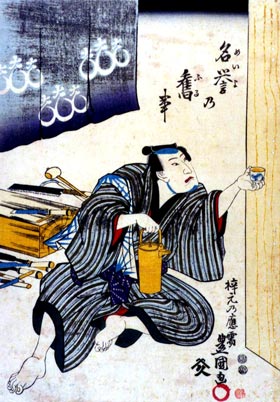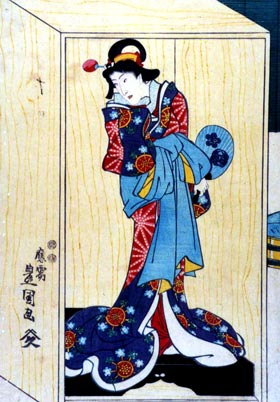| KYď NINGYď |
| Play titles | Meisaku Hidari Kogatana Shiki no Hina Asakusa Hakkei Nisekakete Chikai no Horimono |
| Authors | Sakurada Jisuke III (lyrics) Kishizawa Shikisa V, Kineya Katsugor˘ II (music) |
| History |
The dance-drama "Shiki no Hina Asakusa Hakkei" (commonly called "Ky˘ Ningy˘") was premiered at the Kawarasakiza in the 4th lunar month of 1847 [casting]. The current title of this dance, "Meisaku Hidari Kogatana", was used for the first time in June 1907 at the Miyatoza (according to the "Kabuki J˘ruri Gedai Yomikata Jiten") [more details]. |
| Key words | Shosagoto Nagauta Tokiwazu Hidari Jingor˘ |
| Summary |
Hidari Jingor˘ has fallen in love with Oguruma, a beautiful courtesan at a Ky˘to pleasure quarters. He has started to carve a doll at his workshop, which looks like the courtesan. When the carving is done, he asks his wife Otoku to prepare a tray of drinks and delicacies to celebrate the completion of the doll. Jingor˘ opens the wooden box which contains the doll as he would like to enjoy his drink in the company of the doll. Fascinated by his creation, he feels like drinking together with the wooden Oguruma. Suddenly, the doll walks stiffly out of the box toward Jingor˘. Flabbergasted, he can't believe it and thinks that Otoku must have taken the doll out of the box to please him. But the doll looks no more like a wooden doll, it looks like a woman made of flesh and blood. The doll takes a few more steps toward Jingor˘, who has no other choice than acknowledging the fact that the doll has really come to life. Her movements are quite stiff, walking like a man, not a woman. As he has created this creature, Jingor˘ understands that he has insufflated his own masculine spirit in the doll. In Japan, it is said that a woman's mirror is her soul. Jingor˘ quickly takes out the mirror of Oguruma, which is in his possession, and gives it to the doll. She immediately takes on a lovely femininity, moving now like an accomplished courtesan. Jingor˘ is overjoyed and drinks and dances with her newly-created sweet-heart. He accidentally removes the mirror from the doll, which instantaneously reverts to her previous masculine style. Jingor˘ has to quickly give back the mirror to the doll in order to continue to party with her, not him. Strange men disguised as carpenters interrupt them. They enter the workshop and demand that Jingor˘ hand over Princess Izutsu, daughter of daimy˘ to whom Jingor˘ is deeply indebted. Jingor˘ and his wife have sheltered Princess Izutsu. They've disguised her as their own daughter. Unfortunately for them, the trick was discovered. Jingor˘ answers the false carpenters that he will behead Izutsu himself and give them the head. They are asked to wait outside Jingor˘'s house. Once the men are outside, Jingor˘ tells his wife to quickly conduct Izutsu to a safe place. In the meantime, the yakko Teruhei, a servant of Princess Izutsu, arrives at the workshop. Thinking that Jingor˘ is an enemy of his clan, he attacks the woodcarver. Teruhei succeeds in cutting Jingor˘'s right arm. Otoku rushes in with Princess Izutsu, who recognizes Teruhei and clarifies the situation. Then, Princess Izutsu is hurriedly escorted by Otoku and Teruhei away from the house. The enemies reappear, realizing that they have been duped by Jingor˘. The dance ends with a tachimawari, with Jingor˘ fighting with his left hand against the carpenters, who are pressing in on him with many different carpenter tools. This summary would have not been possible without the help of Sekidobashi Sakura! |
 |
 |
|
The actors Nakamura Utaemon IV (left) and Onoe Baik˘ IV (right) playing the roles of Hidari Jingor˘ and the spirit of the doll in the dance-drama "Shiki no Hina Asakusa Hakkei", which was staged in the 4th lunar month of 1847 at the Kawarasakiza (print made by Utagawa Toyokuni III) |
|
|
|
| Contact | Main | Top | Updates | Actors | Plays | Playwrights | Programs | Links | FAQ | Glossary | Chronology | Illustrations | Prints | Characters | Derivatives | Theaters | Coming soon | News |